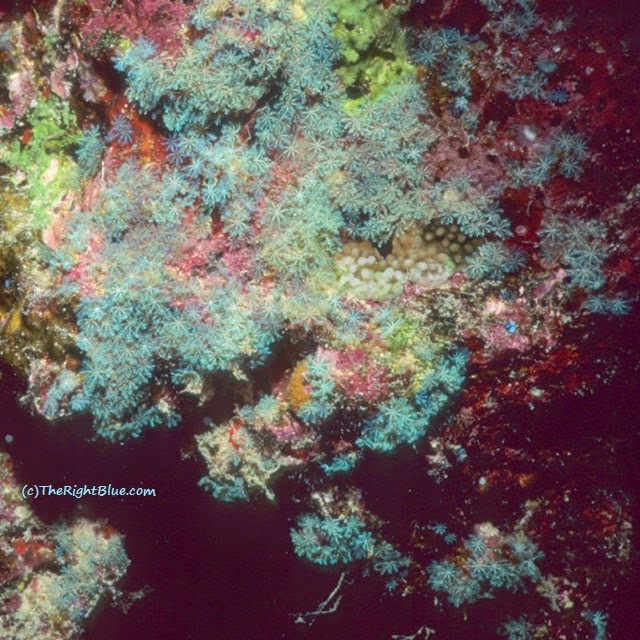BNSullivan.jpg) |
| Channel Clinging Crab (Mithrax spinosissimus) |
by B. N. Sullivan
We were on a night dive in the Turks and Caicos Islands when we came across this crab. It is a Channel Clinging Crab (
Mithrax spinosissimus), the largest species of Caribbean reef crab.
How big is he? We estimated that this crab's carapace measured about 15 cm (6 inches) across. If you could measure across its spread-legged footprint, however, it would easily be over to 30 cm (12 inches).
We were scanning around with our lights across a sandy area off the coast of West Caicos, when we saw this crab gallumphing along, hunting for his dinner. I had been shooting macro photos earlier that day, but for some reason I did the night dive with a wide angle (15mm) lens on my camera. As it turned out, that lens allowed me to get these wide angle close-up shots of this crab.
We located this crab out on the sand flat, at a depth of about 15 meters (50 feet). I maneuvered around in the dark to position myself to intercept its path. I settled on the sand just a meter or so in front of the critter, while Jerry shone a small beam of light on it from above so that I could set up the shot. I waited, and when the big crab was right in front of me, I snapped the shutter release. The result is the first photo on this page. By chance, I managed to capture him just as he began to raise one of those claws in defense!
Of course, as soon as the camera's strobe blasted the poor crab with bright light, he decided to leave in a hurry. He 'turned on a dime' and retreated quickly, but not before I was able to capture an image of the posterior of his carapace and those wonderful, bristly, spidery walking legs!
BNSullivan.jpg) |
| Channel Clinging Crab (Mithrax spinosissimus), posterior view |
We know this species by the common name Channel Clinging Crab, but it turns out that it has several other common names, including Reef Spider Crab, and Spiny Spider Crab, among others. The crab's scientific name is
Mithrax spinosissimus, and that designation stays the same, independent of the common name, which varies from place to place. This crab belongs to the
Majidae family and is a 'true crab' (as opposed to, say, a hermit crab).
Majidae tend to have long slender legs -- just like this example -- which is why the common names of many species in this family include the word 'spider'.
Majids also tend to have little hairs or bristle-like structures on their carapaces. Bits of material -- algae, sponge, and so on -- attach to those hairs and act as part of the crab's camouflage.
Note that the walking legs of this species also are rather hairy, and are covered with 'stuff' while the business end of the crab -- those impressive claws -- are smooth.
Like so many reef creatures, this species forages mainly at night. During the day, they hunker in the reefs, under ledges, and in cavelets. Because of their size, they can't wiggle into small cervices like so many smaller species can do. Still, they can be difficult to spot during the day, since their decorated carapaces blend so well with their surroundings.
These crabs inhabit a range from the sub-tropical western Atlantic to the Caribbean. They can be found in reef areas along the coasts of southern Florida, through the Bahamas and the Turks and Caicos Islands, and throughout much of the Caribbean.
BNSullivan.jpg)

BNSullivan.jpg)
BNSullivan.jpg)
BNSullivan.jpg)
BNSullivan.jpg)
BNSullivan.jpg)
BNSullivan.jpg)
BNSullivan.jpg)
BNSullivan.jpg)
BNSullivan.jpg)
BNSullivan.jpg)
BNSullivan.jpg)
BNSullivan.jpg)
BNSullivan.jpg)
BNSullivan.jpg)
BNSullivan.jpg)
BNSullivan.jpg)
BNSullivan.jpg)
BNSullivan.jpg)
BNSullivan.jpg)

BNSullivan.jpg)
BNSullivan.jpg)
BNSullivan.jpg)
BNSullivan.jpg)
BNSullivan.jpg)
BNSullivan.jpg)
BNSullivan.jpg)
BNSullivan.jpg)
BNSullivan.jpg)
BNSullivan.jpg)
BNSullivan.jpg)
BNSullivan.jpg)
BNSullivan.jpg)
BNSullivan.jpg)
BNSullivan.jpg)
BNSullivan.jpg)
BNSullivan.jpg)
BNSullivan.jpg)

BNSullivan.jpg)
BNSullivan.jpg)

